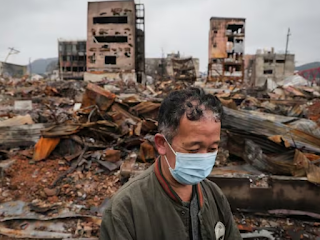Japan has issued an unprecedented "megaquake" advisory following a significant 7.1-magnitude earthquake that struck off its southern coast on Thursday. The tremor, which has caused injuries to 14 people, has intensified fears about the potential for a much larger earthquake, possibly reaching magnitudes of 8.0 or even 9.0. This advisory is an exceptional measure in response to the unusual severity of the initial quake and the potential risk of a subsequent, even more devastating seismic event.
The advisory has led to widespread panic across Japan. Residents have been observed scrambling to stockpile essential supplies and seeking safety shelters. This heightened sense of urgency is fueled by the advisory’s warnings of the potential for an even more catastrophic earthquake. In response to the gravity of the situation, Japanese Prime Minister Fumio Kishida has canceled his planned four-day trip to Central Asia. Kishida stated, "As the prime minister with the highest responsibility for crisis management, I decided I should stay in Japan for at least a week," emphasizing his commitment to managing the crisis.
Operational adjustments are also underway as a precaution. Bullet trains connecting major cities have been instructed to operate at reduced speeds to mitigate risks. Additionally, nuclear power plants across Japan are under heightened scrutiny. Officials are conducting thorough checks of disaster preparedness plans to ensure safety in the event of a significant seismic event.
Although scientists cannot predict earthquakes with absolute certainty, technological advancements have improved the forecasting of high-risk periods. The Japan Meteorological Agency (JMA) has emphasized that while the likelihood of a major earthquake is currently elevated, it does not guarantee that such an event will occur. The advisory calls on residents to prepare for possible worst-case scenarios, review evacuation routes, and remain vigilant for any additional warnings.
Japan’s geographical location along the Ring of Fire makes it highly susceptible to frequent seismic activity, with approximately 1,500 earthquakes occurring annually, most of which are minor. The current advisory is specifically related to the Nankai Trough 'subduction zone,' where tectonic plates in the Pacific Ocean interact. This region is known for accumulating stress that, if released suddenly, could result in a megaquake.
Historical data and recent studies suggest that while the probability of a large earthquake following a magnitude-7 event is relatively low, it is significant enough to warrant precautionary measures. The central government had previously projected in 2022 that a megaquake could strike within the next 30 years with a 70% probability, a scenario that poses a serious threat of significant loss of life and extensive economic damage.
The advisory underscores the severity of the current seismic threat and highlights the importance of vigilance and preparedness in one of the world’s most earthquake-prone regions. As Japan braces for the potential impact of a major quake, the nation is on high alert, with both authorities and citizens taking steps to mitigate the risk and ensure safety.



